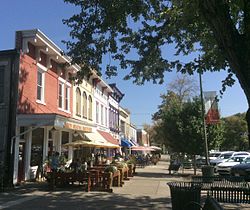Granville, OH
| Granville, Ohio | |
|---|---|
| Village | |

Granville streetscape
|
|
| Motto: "One of Ohio's Best Hometowns" | |
 Location of Granville, Ohio |
|
 Location within Licking County |
|
| Coordinates: 40°4′3″N 82°30′44″W / 40.06750°N 82.51222°WCoordinates: 40°4′3″N 82°30′44″W / 40.06750°N 82.51222°W | |
| Country | United States |
| State | Ohio |
| County | Licking |
| Government | |
| • Mayor | Melissa Hartfield |
| • Village Manager | Steve Pyles |
| Area | |
| • Total | 4.71 sq mi (12.20 km2) |
| • Land | 4.68 sq mi (12.12 km2) |
| • Water | 0.03 sq mi (0.08 km2) |
| Elevation | 961 ft (293 m) |
| Population (2010) | |
| • Total | 5,646 |
| • Estimate (2012) | 5,638 |
| • Density | 1,206.4/sq mi (465.8/km2) |
| Time zone | Eastern (EST) (UTC-5) |
| • Summer (DST) | EDT (UTC-4) |
| ZIP code | 43023 |
| Area code(s) | 740 |
| FIPS code | 39-31402 |
| GNIS feature ID | 1061369 |
| Website | Village website |
Granville is a village in Licking County, Ohio, United States. The population was 5,646 at the 2010 census. The village is located in a rural area of rolling hills in central Ohio. It is 35 miles east of Columbus, the state capital, and 7 miles west of Newark, the county seat.
Granville is home to Denison University. The village is known for its wide central avenue, New England character and historic architecture, including Greek Revival structures like the Avery Downer House, St. Luke's Episcopal Church (1837) and many others. The Buxton Inn (1812), the Granville Inn (1924), Bancroft House (1834) and Bryn Du Mansion are local landmarks. The Granville Opera House, which formerly graced the corner of West Broadway and South main Street, burned to the ground in 1982 and was replaced with a public park.
Granville was founded in 1805 by a colony of settlers from Granville, Massachusetts, who named the new village after their former home. The area was first surveyed in 1797, as land set aside for those who had served in the Revolutionary War. Among the earliest settlers were Theophilus Rees and Thomas Philipps who were born in Wales and left in 1795 for a new life on the American frontier. The village's Welsh heritage is still evident in numerous place names.
Education was a pillar of early civic life. The village's pioneer settlers had built a three story brick school house by 1820. By the 1830s there were five schools in the village. As those educational institutions continued to develop through the mid and late 19th century, they began to serve students from throughout the region as well as from the village. Among those institutions were the Granville Literary and Theological Institution, the Granville Female Seminary, the Granville Episcopal Female Seminary, the Young Ladies’ Institute, the Granville Female Academy, Doane Academy, and Shepardson College for Women. As several of the institution's names indicate, the education of young women was highly valued by the village's early settlers. Several of these institutions evolved into what is today Denison University.
...
Wikipedia
